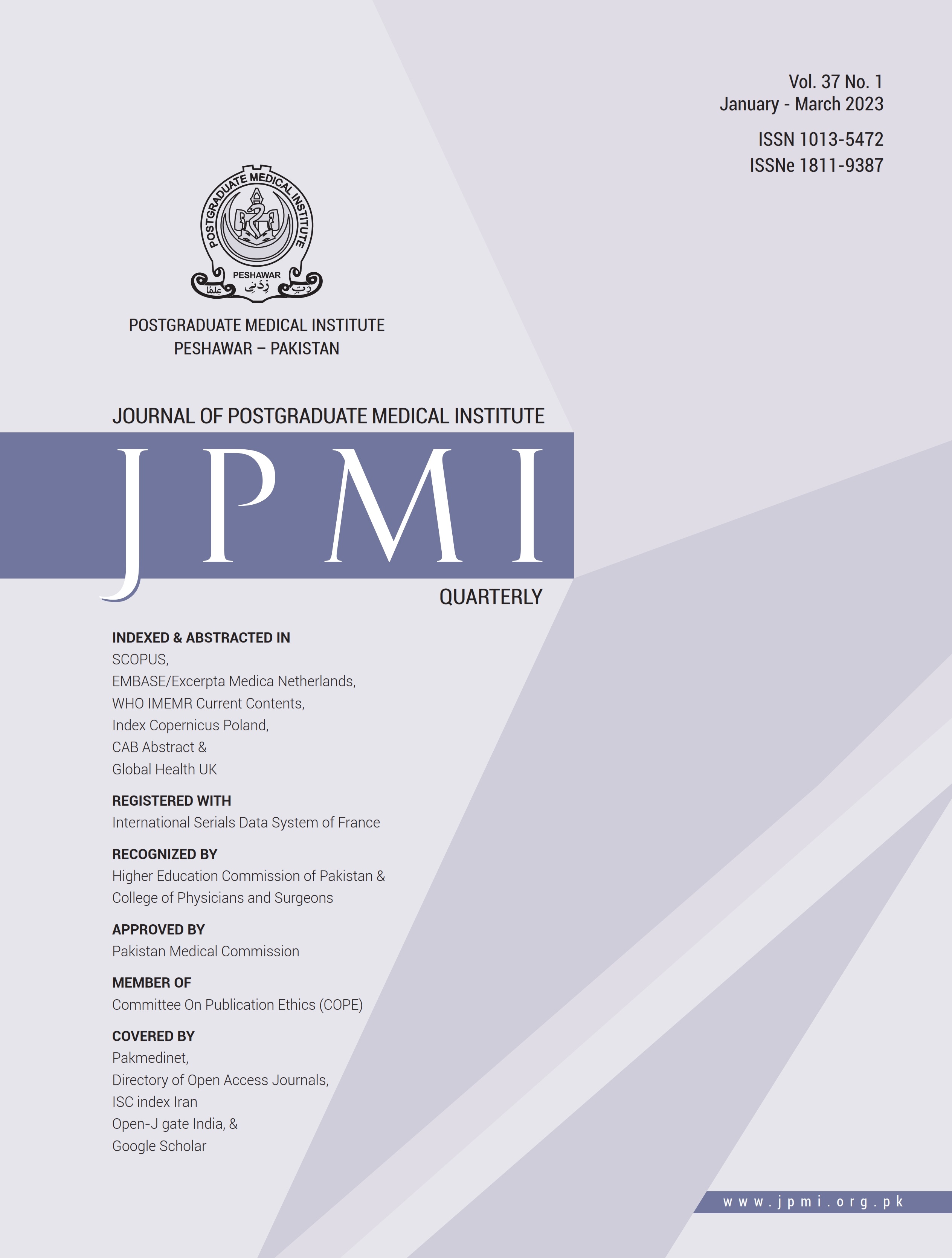DEVELOPMENT AND VALIDATION OF DYSFUNCTIONAL DAYDREAMING SCALE
Main Article Content
Abstract
Objective: To develop a valid and reliable Dysfunctional Daydreaming Scale (DDS).
Methodology: This study aimed to create the item pool for the DDS and was conducted in three phases. In the second phase, 45 items out of a total of 67 items were selected for administration to a sample of 40 individuals, chosen through purposive sampling from Gujrat and Sialkot and ranging in age from 12 to 60 years. In the first phase, semi-structured interviews were conducted with four clinical psychologists and two psychiatrists, as well as ten individuals aged 20 to 60 years. The items were evaluated by five experts in psychology.
Results: The Kaiser-Meyer-Olkin measure of sampling adequacy (KMO=0.924) and Bartlett's test of sphericity (x2=6717.842, p<.001) were satisfactory. The exploratory factor analysis identified two factors, "Escapes" and "Emotional Distress," for the DDS with a reliability coefficient of .94 and satisfactory concurrent validity with the MDS (r=.75, p<.01).
Conclusions: The DDS is a reliable and valid psychometric test that has been developed locally to evaluate maladaptive thought patterns that may serve as a risk factor for the development of psychiatric disorders.
Article Details
Work published in JPMI is licensed under a
Creative Commons Attribution-NonCommercial 2.0 Generic License.
Authors are permitted and encouraged to post their work online (e.g., in institutional repositories or on their website) prior to and during the submission process, as it can lead to productive exchanges, as well as earlier and greater citation of published work.
References
Baruss I. Alterations of consciousness: An empirical analysis for social scientists. American Psychological Association; 2003. DOI: 10.1037/10562-000
Somer E, Soffer-Dudek N, Ross CA. The Comorbidity of Daydreaming Disorder (Maladaptive Daydreaming). J Nerv Ment Dis. 2017;205(7):525-30. DOI:10.1097/ NMD.0000000000000685.
Somer E. Maladaptive daydreaming: A qualitative inquiry. J Contemp Psychother. 2002;32(2):197-212.
Somer E, Soffer-Dudek N, Ross CA, Halpern N. Maladaptive daydreaming: Proposed diagnostic criteria and their assessment with a structured clinical interview. Psychol Conscious (Wash D C). 2017;4(2):176.-189. DOI:10.1037/ cns0000114
Bigelsen J, Lehrfeld JM, Jopp DS, Somer E. Maladaptive daydreaming: Evidence for an under-researched mental health disorder. Conscious Cogn. 2016;42:254-66. DOI:10.1016/j.con-cog.2016.03.017.
Pietkiewicz IJ, Necki S, Banbura A, Tomalski R. Maladaptive daydreaming as a new form of behavioral addiction. J Behav Addict. 2018;7(3):838-43. DOI: 10.1556/2006.7.2018.95
Wilson SC, Barber TX. Vivid fantasy and hallucinatory abilities in the life histories of excellent hypnotic subjects (“somnambules”): Preliminary report with female subjects. In:Concepts, results, and applications. Boston, MA: Springer; 1981.
Somer E, Herscu O. Childhood Trauma, Social Anxiety, Absorption and Fantasy Dependence: Two Potential Mediated Pathways to Maladaptive Daydreaming. J Addict Behav Ther Rehabil. 2017:6(3)1-5. DOI: 10.4172/2324- 9005.1000170
Zelin ML, Bernstein SB, Heijn C, Jampel RM, Myerson PG, Adler G, et al.The Sustaining Fantasy Questionnaire: Measurement of sustaining functions of fantasies in psychiatric inpatients. J Pers Assess. 1983;47(4):427- 39. DOI:10.1207/s15327752jpa4704_13..
Uslu H. Understanding the relationship between media use and maladaptive daydreaming. Georgetown University; 2015.
Bigelsen J, Schupak C. Compulsive fantasy: Proposed evidence of an under-reported syndrome through a systematic study of 90 self-identified non-normative fantasizers. Conscious Cogn. 2011;20(4):1634-48. DOI:10.1016/j.concog.2011.08.013.
Rich RM, Ogden J, Morison L. A randomized controlled trial of an app-delivered mindfulness program among university employees: effects on stress and work-related outcomes. Int J Workplace Health Manag. 2021;14(2):201–16. DOI:10.1108/ijwhm-04-2020-0046.
Somer E, Lehrfeld J, Bigelsen J, Jopp DS. Development and validation of the Maladaptive Daydreaming Scale (MDS). Conscious Cogn. 2016;39:77-91. DOI:10.1016/j.concog.2015.12.001.
Somer E, Abu-Rayya HM, Schimmenti A, Metin B, Brenner R, Ferrante E, et al. Heightened levels of maladaptive daydreaming are associated with COVID-19 lockdown, pre-existing psychiatric diagnoses, and intensified psychological dysfunctions: A multi-country study. Frontiers in psychiatry. Front Psychia-try. 2020;11:587455. DOI:10.3389/ fpsyt.2020.587455
Anthoine E, Moret L, Regnault A, Sebille V, Hardouin JB. Sample size used to validate a scale: a review of publications on newly-developed patient reported outcomes measures. Health Qual Life Outcomes. 2014;12:176. DOI:10.1186/s12955-014-0176-2.
Ford JK, MacCallum RC, Tait M. The application of exploratory factor analysis in applied psychology: A critical review and analysis. Pers Psychol. 1986;39(2):291–314. DOI:10.1111/j.1744-6570.1986. tb00583.x.
Field A. Discovering Statistics Using SPSS: (and Sex and Drugs and Rock ‘n’ Roll). Thousand Oaks, CA: Sage Publications; 2009.
Kaiser HF. An index of factorial simplicity. Psychometrika. 1974;39(1):31-6.
Hadi NU, Abdullah N, Sentosa I. An easy approach to exploratory factor analysis: Marketing perspective. J Educ Soc Res. 2016;6(1):215. DOI:10.5901/ jesr.2016.v6n1p215.
Anwar M, Aqeel M, Shuja KH. Linking Social Support, Social Anxiety and Maladaptive Daydreaming. Found Univ J Psychol. 2018;2(2):140-80. DOI:10.33897/fujp2.16
Kiran I, Ahsan S, Zonash R. Self-generated thoughts as predictors of depressive symptoms among university students. Pak J Physiol. 2020 Mar 31;16(1):52-5.
Uslu H. Understanding the relationship between media use and maladaptive daydreaming. Georgetown University; 2015.


